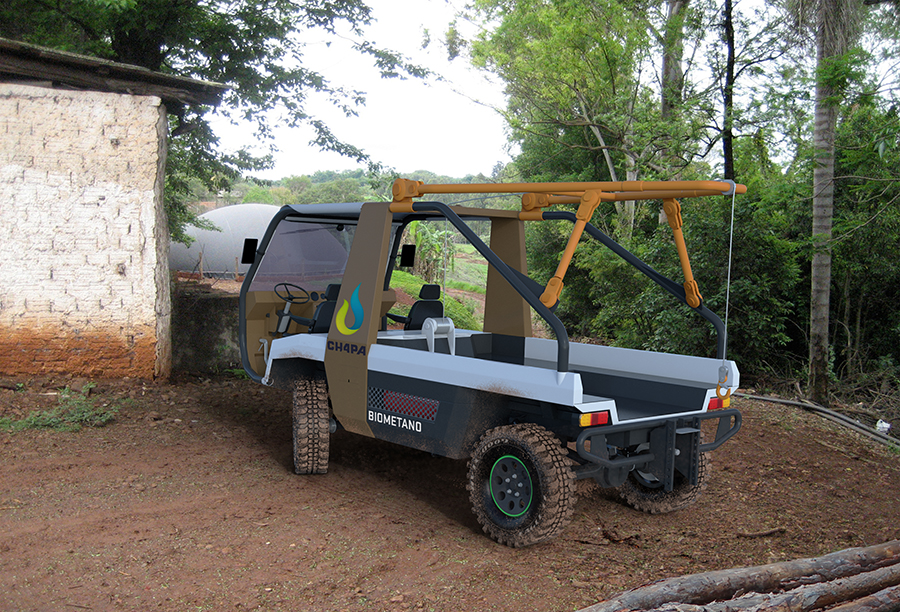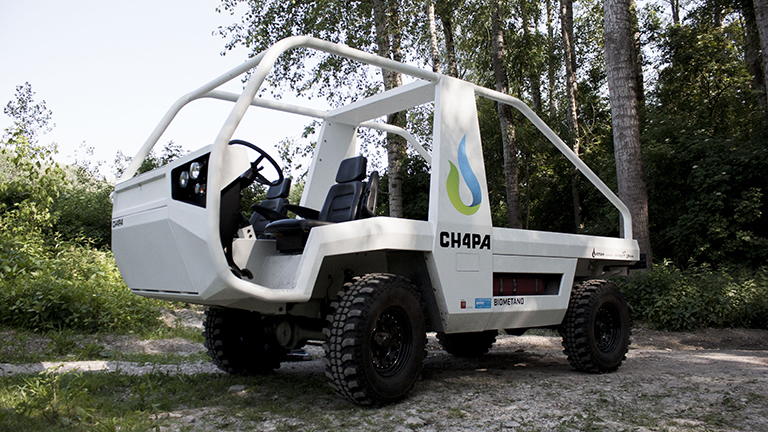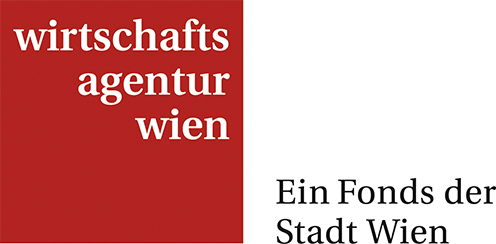One could call it a coincidence or attribute it to fate. In talks with the University of Natural Resources and Life Sciences Vienna, other research institutions and NGOs, Managing Director Georg Wagner chose the right moment to reveal our Compact tractor OX concept. It quickly became apparent that not only the purchase costs of machines comprise the actual obstacle for small farmers in emerging and developing countries, but above all the maintenance costs. By focusing on alternative energy sources, the idea arose to operate a vehicle with processed biogas which the small farmer produces himself. Our concept became the symbol for initial reflections on biogas-based, rural mobility, and has been subject to rapid further development and changes in different project phases up until the finished prototype.
Our CH4PA (prounounced “Schapa“) was developed on the basis of the original OX project. Its name is derived from using methane (=CH4) as a fuel. As the best friend of small farmers (chapa = Portuguese slang for buddy), this environmentally compatible and affordable working device increases the productivity of small farmers.


The flexible camerade of farmers
Spirit Design developed the prototype of the multifunctional labor and transport vehicle for small farmers in emerging markets within the framework of a research and development project funded by the Vienna Business Agency. It was completed at the end of 2014.
CHAPA is powered by biomethane and/or gasoline. Its main purpose in the field of agricultural transport is fulfilled by its offering a maxium of storage capacity. The solid frame allows for various vehicle superstructures and flexible design. Different add-on modules take account of the specific needs of its users.
Downsizing to the bare essentials
Modularity and simplicity were the guiding principles underlying the appearance of CH4PA. The body made from a reduced number of simple components was superimposed on a specially built ladder-type frame as the carrier vehicle. The modular concept for design storage space offers room for different transport and labor modules. The vehicle rear offers a three-point linkage with a power take-off shaft as the coupling for all types of agriculture devices. Integrated hooks an eyelets enable different methods to be mounted as a means of protecting the user from sunlight. The driver’s cabin at the front of the vehicle not only ensures ideal all-round visibility for the driver but also the biggest possible storage space in the vehicle rear and flexible swap bodies.

The appearance of the CH4PA features a particular linearity and shows characteristic aspects related to the niche position of the vehicle, such as its dynamic C frame, which serve as a B-pillar as well as a stable roll bar. It makes a considerable contribution to the autonomy and recognition value of the CH4PA. By reducing the casing, maintenance is simplified for the user, and greater accessibility is ensured. Moreover, ecological aspects are showed off to their best advantage due to the fact that the biomethane tank is also visible from the outside.
Reponse to global challenges
Up until now, it was not possible for small-scale farmers in emerging and developing countries to increase productivity by deploying machinery due to the high costs of acquisition and operation. CP4PA offers a cost-effective, modular vehicle concept which equally covers both labor and transport needs. The vehicle is powerd by biogas produced by the farmers themselves, processed into fuel in local facilities in village communities and from biogenic waste. This not only reduces operating costs compared to previous diesel consumption, but also makes sensible use of agricultural waste by recycling it.

The decentralized energy production from agricultural waste, above all from animal manure, is part of the business model underlying the biogas-driven vehicle. It makes mobility affordable for small farmers in emerging markets. In addition to productivity increases, it opens up additional sources of income and potential in energy production. The standard of living of these sections of the population is thus sustainably improved.
Funded own development from and with Spirit Design
The basis for this own development was developed by Spirit Design in cooperation with renowned partners, the Vienna University of Technolgoy and the University of Natural Resources and Life Sciences, Vienna. In addition to the strategic design and engineering concept, a feasibility study for the drive system and the presentation of a business model weere also part of the overall project.
Within the concept of funding provided by Austria Wirtschaftsservice (AWS Impulse XS), expert discussions with potential partners in the fields of engineering and biogas infrastructure were held, and strategic partners were identified. Based on a feasibility study, a detailed business plan was prepared as well as a financing concept for vehicle development.

The first prototype was developed at the end of 2014 in collaboration with prominent industrial partners. This project phase was funded within the context of a funding program of the Vienna Business Agency. It includes the technical specifications as well as discussions with engineering companies as potential project partners responsible for vehicle construction. The research institute Virtual Vehicle carried out a technical study to prepare the underlying product development strategy.
Specific deployment of the vehicle and the building up of the related biomethane infrastructure are being simultaneously prepared in an agricultural pilot region in Brazil. See Atmove Biogas Innovation Center.
